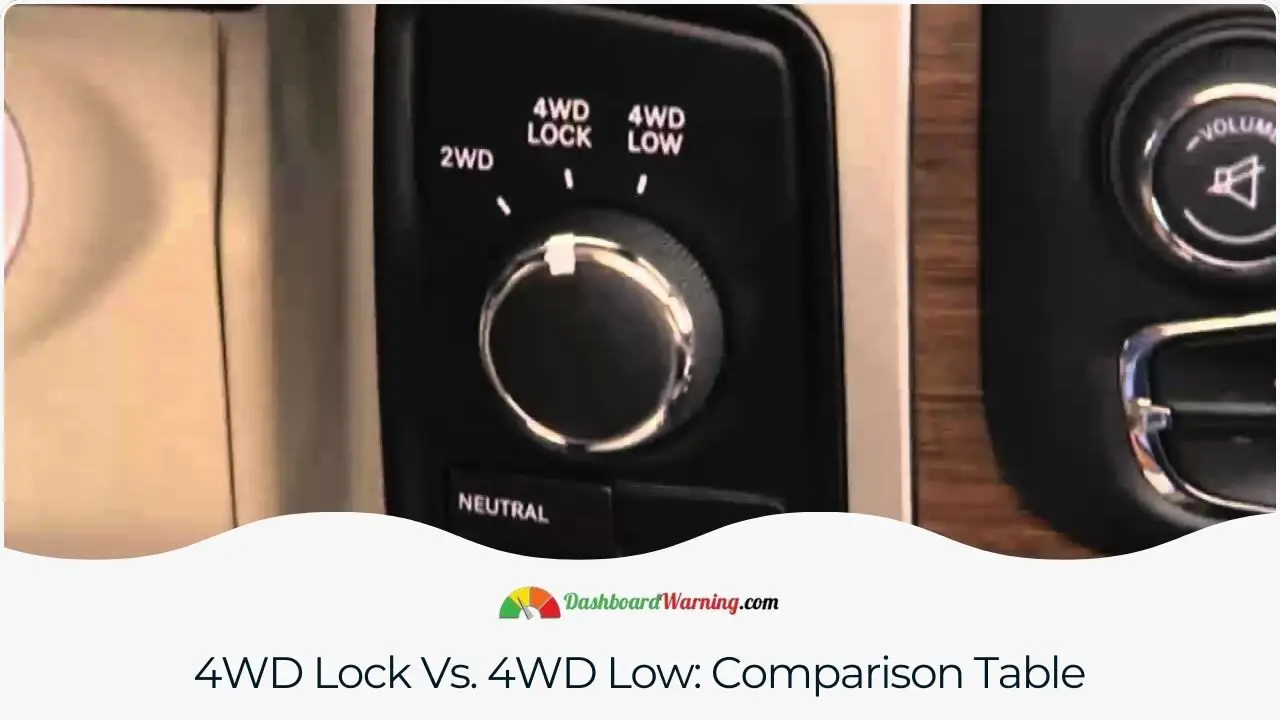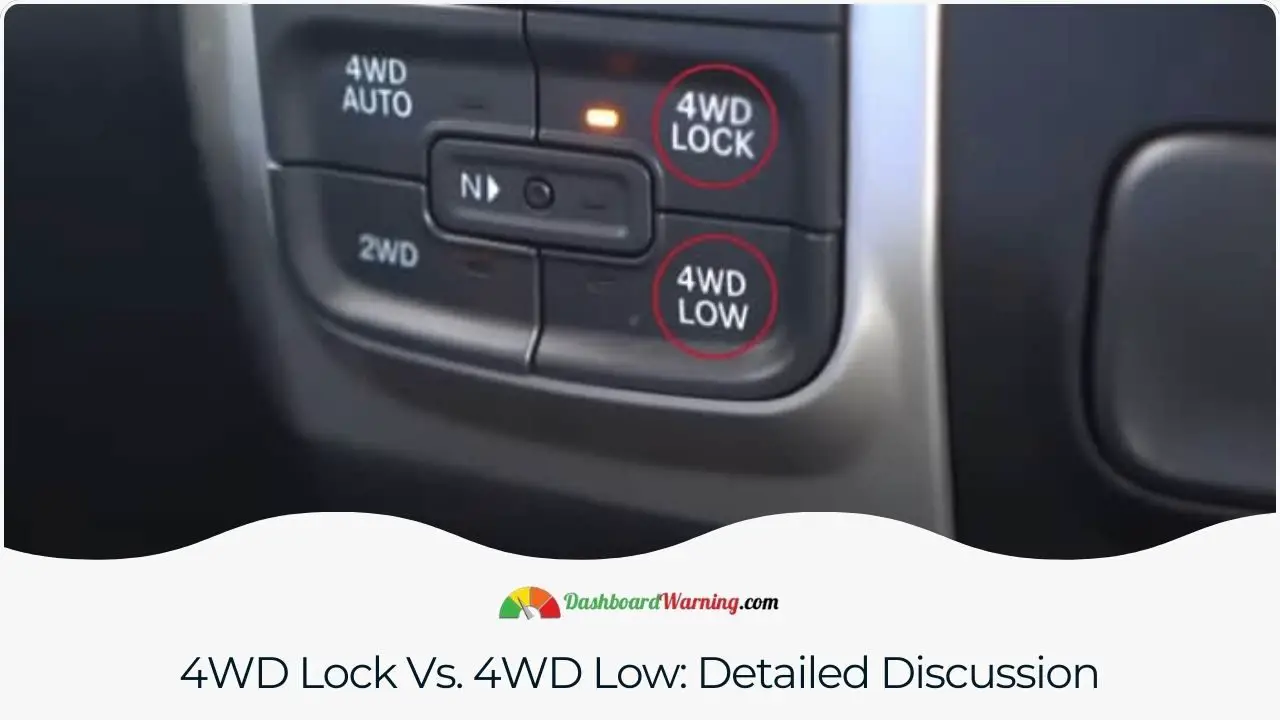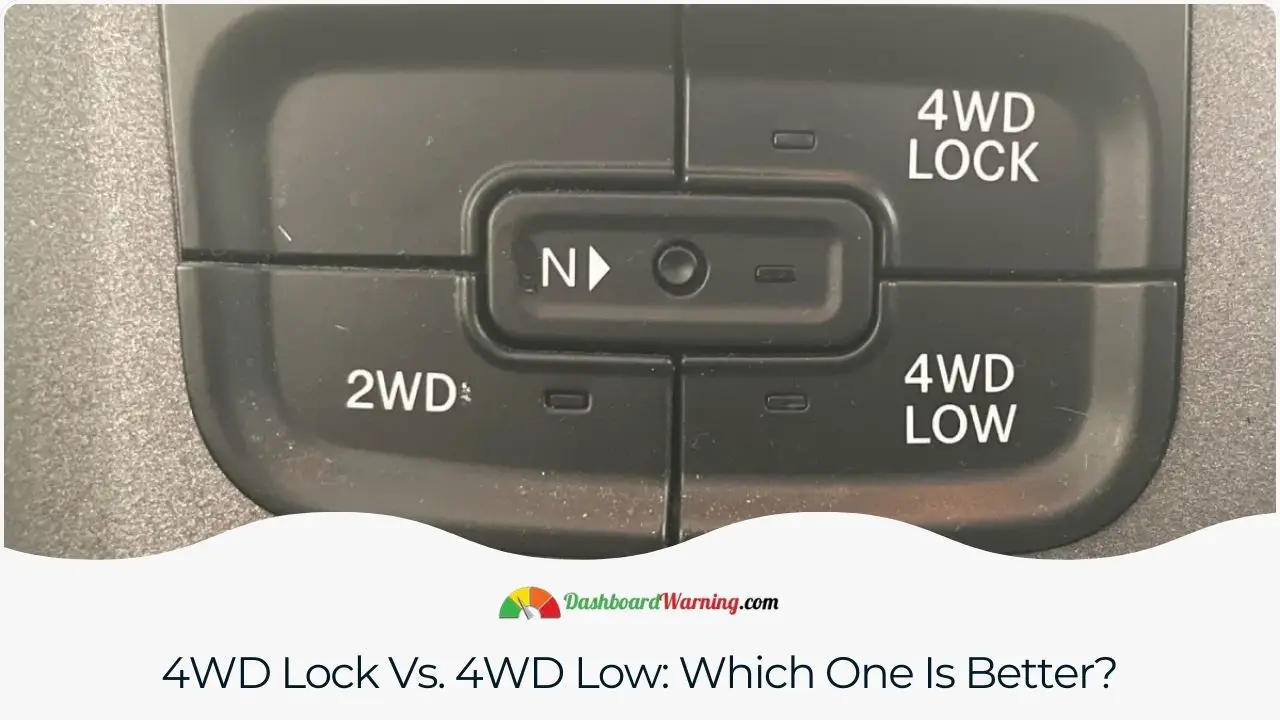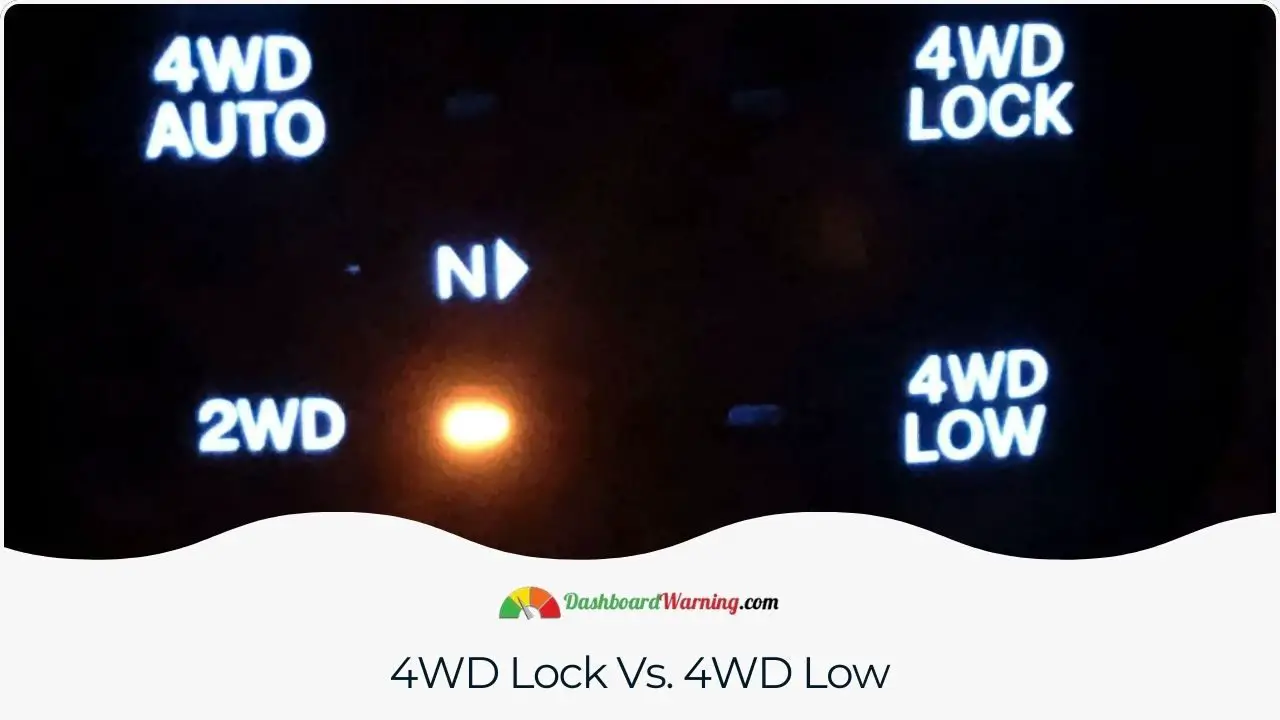Four-wheel drive (4WD) is a system of power transmission in which torque and power are sent to all four wheels simultaneously. This feature allows vehicles such as off-road SUVs and work trucks to handle washed-out roads and large craters as long as one or more tires remain on the ground. 4WD Lock connects the front and rear axles for added traction when driving on slippery surfaces—such as steep inclines—to escape tough off-road conditions.
Although they have many similarities, 4WD Lock and 4WD Low differ mainly in their mechanisms. Compared with 4WD Lock, which links both axles together for increased traction, 4WD Low provides an even greater amount of torque at a reduced speed; this setup is beneficial when navigating tight turns or scaling challenging terrain.
Furthermore, some vehicles have additional features that can be used in combination with either mode: Hill Descent Control helps maintain vehicle movement while descending slopes without driver intervention; Traction Control prevents excessive wheel spin by reducing engine power when necessary; Electronic Stability Control adjusts steering inputs if the car skids or veers away from its intended trajectory.
In conclusion, drivers should familiarize themselves with both systems before taking any vehicle off-road under harsh conditions. Although similar, each has unique benefits that can help you traverse difficult terrain safely and efficiently regardless of weather or surface conditions encountered along your journey.
4WD Lock Vs. 4WD Low - Comparison Table

More torque is often required when driving over rough terrain or deep sand. A 4WD low gear ratio is an effective solution for this issue, as it reduces the engine’s rpm and provides enough power to the wheels to move forward. Understanding both 4WD Lock and 4WD Low comparison tables is important to make a well-informed decision when choosing between them.
| 4WD Lock | 4WD Low |
| Used for off-road driving | Used for on-road situations |
| 4WD Low has a higher gear ratio | 4WD Low has a bit low gear ratio |
| Driving both front & rear wheels simultaneously | 4WD low is 4WD, but it works in a low-gear |
| Work better on dry road | Not suitable on dry road |
| Used in any situation where you wish to drive the vehicle’s 4 wheels together | 4WD Low also can reduce engine speed & vehicle speed, improving fuel economy |
| Drivers should engage the 4WD lock when operating on surfaces such as gravel, sand, or snow to minimize the risk of spinning. | A 4WD low ideal vehicle with four-wheel drive capability for climbing rocky terrain, fording creeks, navigating sand and mud |
4WD Lock vs. 4WD Low - Detailed Discussion

This article comprehensively overviews the differences between 4WD Low and 4WD Lock. It discusses performance on different terrains, methods for turning your vehicle into 4WD, gas mileage, and the effects of driving at higher speeds while in 4WD. Additionally, it explains how to choose the best setting depending on conditions like terrain or weather to get maximum efficiency from your vehicle. By properly understanding the differences between these settings, users can confidently make informed decisions that will help them save money and stay safe while driving off-road.
4WD Lock: What Does It Do?
4WD Lock is a 4-wheel-drive technology that allows all four wheels on a vehicle to rotate simultaneously, providing increased traction and control when driving off-road. It connects the front and rear axles of 4WD vehicles, creating an even power distribution between all four wheels. This ensures the car has improved grip in slippery or difficult conditions such as steep hills and rough terrain. This advanced feature provides drivers with extra confidence when navigating challenging routes.
4WD Low: What Does It Do?
The 4WD Low model is a sophisticated four-wheel-drive system that allows each vehicle wheel to rotate independently, providing improved performance in on-road situations where extra traction is not required. This system offers an advantage over traditional two-wheel drive systems because it has a lower gear ratio, which helps when driving over sand and rough terrain. It reduces the engine speed while providing enough power for the wheels to move the vehicle.
Specifications
Driving with a 4WD lock engaged is a great way to make sure you cross difficult terrain safely, but it's important to know the implications of doing so. The vehicle may be subjected to greater forces than necessary or safe for road conditions at highway speeds. As such, when using a 4WD lock, it is best practice to keep vehicles driving between 25 and 40 mph.
Several factors must be considered when considering whether or not to shift your vehicle into 4WD mode. For low-speed traction in rough terrain, a driver should consider using 4WD Low instead of High, which should only be employed at higher speeds. This setting can also handle deep snow, sand, rock crawling, and stream crossings. However, drivers must never use this setting on ice since the wheels will not move due to being under massive torque and slippery surfaces.
Finally, one should never attempt driving with their 4WD always engaged on smooth, dry roads since this will cause premature wear on their axles from bumps & thumps caused by corners. Plus, the fact that these settings are optimized for rough terrains makes them unsuitable for such surface types.
Capability Utilization
Driving off-road or in poor weather conditions can be challenging, especially without the right equipment. A 4WD Lock effectively manages traction and power when operating on rough terrain like ice or snow. When activated, the wheels lock together, allowing them to move simultaneously, providing improved traction and stability with reduced engine and vehicle speeds.
For those looking to optimize their vehicle’s performance on difficult terrains, 4WD Low mode is a great option. It increases power at the wheels while evenly distributing weight across all four corners of the car – thus improving fuel economy and stability during climbs or while pulling heavy loads. Additionally, it reduces engine and vehicle speeds, which can be beneficial when navigating tricky roads or trails.
Ultimately, then, if you have a 4-wheel drive (4WD) vehicle, you should consider activating your 4WD Lock when taking it out onto difficult terrain; this will enhance your safety by helping improve traction while also providing more efficient power distribution & lighter load pulls along with enhanced fuel economy rates that could come in handy for longer trips away from home!
Driving Conditions
Driving in off-road conditions can be challenging, but the Jeep Renegade's 4WD Lock mode ensures optimal performance capacity. With this mode engaged, the torque distribution will be modified so that all four wheels work together to provide maximum traction and control. This setting should only be used when driving in extreme mud, sand, or steep slopes.
The Jeep Renegade also has a 4WD Low feature, which allows drivers to tackle more difficult terrain, such as rocks, creeks, and sand, without worrying about slipping or spinning out of control due to lack of power or traction. When using this setting, drivers should keep their speed under 40mph since it causes the wheels to turn slower than usual. This mode is perfect for snowy roads, light off-road paths, and muddy areas.
If you need extra power on slippery surfaces, you can switch from 4WD Low back to 4WD High anytime by simply engaging the dial selector inside the vehicle's cabin. Doing so gives power to all four wheels and increases your chances of easily overcoming obstacles! No matter what type of terrain you're tackling in your Renegade - whether it’s urban streets or rugged trails - make sure you have access to both modes if needed for optimal safety and performance.
4WD Lock vs. 4WD Low - Which One Is Better?

Driving in 4WD requires understanding the appropriate use of its features. The Lock feature should only be used when operating over surfaces such as gravel, sand, or snow where spinning can occur. Each tire is locked together when engaged, allowing them to rotate at the same speed. This helps to prevent tires from spinning and causing problems during your drive.
Low-range 4WDs are preferable when off-roading because they maximize power and traction for climbing rocky terrain, fording creeks, and navigating sand and mud or steep paths. On smooth pavement, however, it’s unnecessary to engage this feature as it may cause damage to your vehicle’s drivetrain if used in dry conditions. Ultimately, depending on personal preferences and road conditions, it's up to the driver.
In conclusion, knowing how and when to use the Lock feature in a 4WD vehicle is essential for safe driving in all kinds of terrain -from icy roads to muddy paths; but also understanding that engaging this feature while driving on dry pavement might damage your car's transmission system so is important too!
When considering the differences between 4WD Lock vs. 4WD Low, it is important to understand that the former is an interlocked four-wheel drive that cannot be disengaged. On the other hand, 4WD Low allows drivers to engage and disengage the four-wheel drive when driving at low speeds for applications such as off-roading. Ultimately, your preference will depend on your specific needs and preferences.
Was this page helpful?


More important content about Tips and Advice
Porsche Cayenne Years To Avoid
Subaru Legacy Years To Avoid - 5 Worst Years
Pt Cruiser Years To Avoid
Use 5w30 instead of 0w20 - Advantages and Disadvantages
Tractor Dashboard Symbols And Meanings
Tips and Advice
Subaru Legacy Years To Avoid - 5 Worst Years
Pt Cruiser Years To Avoid
Use 5w30 instead of 0w20 - Advantages and Disadvantages
Tractor Dashboard Symbols And Meanings
Suzuki Sx4 Years To Avoid - 5 Worst Years
Cummins ISX Years To Avoid and Why